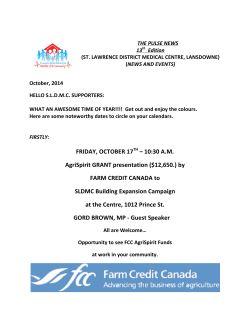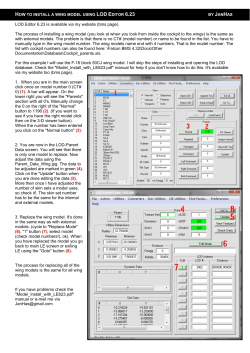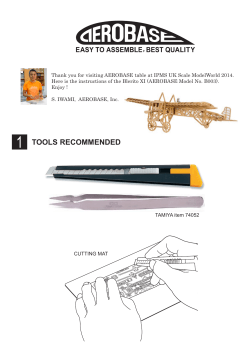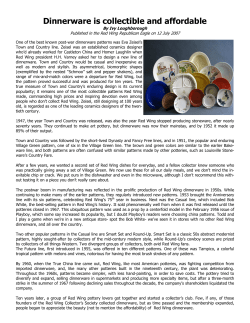
A Preliminary Study of the Three
Journal of Applied Science and Engineering, Vol. 15, No. 3, pp. 257-263 (2012) 257 A Preliminary Study of the Three-Dimensional Aerodynamics of Flapping Wings Yang-Yao Niu1*, Shin-Han Liu2, Che-Cheng Chang2 and T. I. Tseng3 1 Department of Aerospace Engineering, Tamkang University, Tamshui, Taiwan 251, R.O.C. 2 Department of Mechanical Engineering, Chung Hua University, Hsinchu, Taiwan, R.O.C. 3 National Center for High-Performace Computing Center, Hsinchu, Taiwan, R.O.C. Abstract A preliminary study of the aerodynamic characteristics of bird-scaled flapping wings is performed. Simulations of vortex behaviors and forces due to the reduced frequency of the three-dimensional flapping wings are investigated. First of all, numerical results of the flapping NACA0012 wing are verified with the experimental data. Secondly, three-dimensional leading edge vortex, tip vortex and trailing edge vortex contours induced by the flapping motions in a cycle are demonstrated. Finally, the current study is extended to discuss the flapping kinematics of a bird-size flapping wings. It is noted that the thrust and lift are enhanced and getting larger as the increasing reduced frequency of the flapping wing from 0.3 to 0.6 under Reynolds number of 60000. Key Words: Flapping Wings, Aerodynamics, CFD, MAV, Lift, Thrust 1. Introduction Birds can produce efficiently aerodynamic forces as lift and thrust forces due to flapping motions of wings, also combining with large flexibility of the wing. Human has fascinated with the bird’s flight in the blue sky for centuries. Most of early concepts of flight were to imitate birds by using the flapping wings. The flight machines were made based on the ways of the flapping from which the pilot could flap the wing by his own labor power. However, that was a wrong idea because of the physiological function of human beings never can match the birds. By means of the hovering flight of the hawk, the fixed-wing flight vehicle was initialized and has been developed continuously to the current popular flight of the human being. As we know, at the beginning of the 20th century, a powered plane was built by Wrights brothers and has successful gilding over few hundred *Corresponding author worked as a faculty at Chung Hua University before Aug., 2012 and E-mail: yyniu@mail.tku.edu.tw feet. Although the aeronautical technology has advanced rapidly over the past century, the flapping wing aircraft is still developed not much. The aerodynamics and mechanics of flapping flight have a big disparity with the traditional fixed-wing flight. It is well know that the traditional aircraft is powered by the propeller or the turbine to perform the flight. The forward flight motion relative to the air causes the flow over the airfoils to produce lift. However, the flapping wing not only produces the lift but also provides the thrust. In the experimental studies of biological flight, Hall [1] surveyed these papers and groups it in three types of wake structure patterns: (1) vortex-ring wake, (2) Continuous-vortex wake and (3) Ladder wake. Lighthill [2] pointed out that the circulation round the wing occurs at the beginning of the downstroke and forms a so-called “starting vortex” from trailing edge. Also, the stream-wise vortices are grouped into the tip vortex. Finally, at the end of the down-stroke also the circulation is derived by a shedding “stopping vortex”; that is equal and opposite of 258 Yang-Yao Niu et al. the starting vortex. A ring vortex is formed of these vortices which has the same circulation G around them in a single downstroke. In slow flight, the bird’s wing is fully expended as a flat plane during the downstroke and as a folding wing during the upstroke which is aerodynamically inactive, so vortex-ring is formed behind the birds. The wing is aerodynamically active both in the downstroke and upstroke in the fast flight. But during the upstroke, it is slightly folding with less effort which reduces the span of the wing, so the continuous-vortex wake is formed. The humming bird’s wing is shorter with large stiffness. It is almost like a plate during the flapping cycle. The starting vortex, tip vortex and ending vortex are shedding around the wing alternatively during the downstroke and the upstroke. Recently, the biomimetics is becoming a major study of the designing the flapping MAV (Micro Air Vehicle). Hao Liu [3] proposed a systematic study of morphology kinematics of the flights of the moth, honey bee and fruit fly based on the Reynolds number. Spedding G. R. [4] used DPIV to observe the bird flight, also understood how the lift from vortex keeps the weight of the bird, Dickinson [5] used the micro flapping device to mimic the flapping motion and captured the wake, the delayed stall and the circulation from difference flapping patterns. Also, Ifju et al. [6] also tested different wings of MAVs based on different Reynolds numbers. Ven den Berg and Ellington [7] used DPIV to observe the hanging flying insect with rigid wings, then find out the observe leading edge vortex on the wing surface. In the study of Ramamurti [8], three parts of the flapping motion were observed as the advanced, the symmetrical and the delayed. In the advanced model, the wing began to flap in the downstroke and generated better thrust than symmetrical model did. In the symmetrical model, higher pressures under the wing were produced to improve lift force. In the delayed model, the wing generated the thrust during the rotation. When the flapping wing is in the downstroke, lift force is much enhanced than in upstroke, however, the wing tip and trailing edge have generated separation flows to reduce thrust force. Aono et al. [9] discovered the insect flight in the hovering flight based on the computations delivering the horseshape vortex (HSV), also understood the doughnutshape vortex ring generating the so-called the downwash flows and destroyed the doughnut-shape vortex to generate the sideslip force to enhance the lift. Shyy et al. [10] in flapping motion have two important findings. First of all, the tip vortex can induce lift force and make leading vortex delay to separate over the wing surface with low aspect ratio. Secondly, the flapping wing reduced transverse momentum and delay the stall to keep the lift. Miller and Peskin [11] investigated the flows at Reynolds number of 32 and 64. They compared with the rigid and flexible clap-cling mechanics and considered non-symmetric material along the leading edge including the effect of the stiffness on the lift and drag. It is noted that the vortex could attach on wing surface in a longer time to delay the stall due to the flexibility of the wing. So the lift can be enhanced. Miao et al. [12] simulated in different flexible amplitudes of the elastic airfoils to perform the aerodynamic analysis. In this work, we will perform the three-dimensional aerodynamic analysis of the flow over NACA0012 airfoils under the wing-wing interactions with different reduced flapping frequencies. The above effects on the lift and thrust relationship and the related vortex evolution would be performed by the commercial package Fluent. 2. Numerical Method 2.1 Government Equations The unsteady three-dimensional incompressible Navier-Stokes equations is chosen as the computational model as (1) (2) where m is viscosity coefficient, m = mL + mT and mT is turbulence viscosity coefficient, mT should be use turbulence model to guide calculation process if investigate in low Reynolds number aerodynamics analysis need to use laminar module at the same time mT is zero. The 3-D timedependent Navier-Stokes equations are solved by means of a commercial CFD package FLuent. It adopts a SIMPLE type finite volume method with a third-order accurate QUICK differencing scheme for all equations. The following 3-D unsteady Navier-Stokes equations were solved for a peak Reynolds number of 6000 at the far-field of computational domains, no-slip solid boundary condi- A Preliminary Study of the Three-Dimensional Aerodynamics of Flapping Wings 259 (3) realistic flight model of the wing-wing interactions of the NACA0012 wing in a moth flight condition is used to simulate the vortex evolution of the wing, then figure out the related lift and drag force distributions. For computational domain, we chose an elliptic shape domain to cover the wing surface; the outer square domain is used to cover the whole computational domain. The orthogonal mesh lines were constructed to the wing surface when using the tetrahedron meshes were adopted as in Figure 3. The total computational mesh is over 3 millions. The chord length is 0.02 m, span is 0.1 m, working flow is air, flapping angle is 30 degree, flapping frequency is 20 HZ, Reynolds number is 60000 and the flapping motion is: (4) (5) aROOT = 0.175c, aROOT is the maximum flapping angle at the root of the wing. ATIP = 1.13aROOT, aTIP is the maximum flapping angle of wing at the tip, f = -4.2°, f is phase angle, more details can be seen in Figure 1. In Figure 2, it is seen that simulated thrust coefficient is in an agreement with experimental data [3]. For further where ar is the flapping angle and k is the reduced frequency. From Figure 4, we can know when the wing flaps in the down stroke, there is a horse-shape vortex around the wing, this vortex combining with leading edge vortex (LEV), tip vortex (TV) and trailing edge tions were chosen for wing surfaces. Pressure outlet condition were chosen as the outflow flow conditions. 3. Discussions First, we study a NACA0012 wing in heave motion compared with three-dimensional validated data of aerodynamics. According to Heathcote et al. [13], in our simulation are: the chord length is 0.1 m, span is 0.6 m, velocity is 0.393 m/s, Reynolds number is 30000, the reduced frequency is 1.82 and the equation of the flapping motion is Figure 3. The mesh of a NACA0012 wing. Figure 1. Schematic of single NACA0012 wing flapping motion [13]. Figure 2. Thrust coefficient of single NACA0012 wing. Figure 4. Velocity vector plot in a flapping downstroke of a NACA0012 wing. 260 Yang-Yao Niu et al. vortex (TEV), also a spanwise vortex flow from the root to the tip of the wing due to the effect of centrifugal force was seen. In Figures 5(a), 6(a) and 5(b), 6(b), it can be seen that the vortex has stronger vorticity in front of the upper surface of the wing to introduce a lower pressure region, and this lower pressure cause larger pressure difference to enhance the lift during the downstroke. When the wing flapping in upstroke, from Figure 5(c) and 6(c), the leading edge vortex and trailing edge vortex were shedding and the shedding leading edge vortex and trailing edge vortex were getting disappeared. From Figure 5-6(d) to Figure 5-6(f), the vorticity of the leading edge vortex and trailing edge vortex under the wings is increased, then the lower sur- face of the wing turned out to be a suction side. Therefore, the lift is decreased. From Figure 5(g), the shedding vortex under the wing was getting disappeared. Figure 5(g), 5(h) compared with Figure 8(a), in Figure 5(g) the shedding vortex can enhance the strength of a newborn vortex over the surface to enhance the lift force. Figure 8(h) shows the shedding leading edge vortex is getting disappeared, but, the trailing edge vortex still exists and the lift is increased to some extent. So the shedding vortex is related to the lift variation. In Figure 7(a), 7(b), 7(g) and 7(h), it is seen that the pressure over the upper surface is lower than the lower surface when the wing is in the downstroke, so the lift is strengthened. But the wing motion is decelerated in the Figure 5. Vortex contours at Z axis cross-sections in an evolution. Figure 6. The plots of contour of helicity vorticity in an evolution of flapping. A Preliminary Study of the Three-Dimensional Aerodynamics of Flapping Wings downstroke; the pressures on the both surfaces are getting equal. In Figure 7(d)-7(f), the wing motion is ac- Figure 7. The plots of pressure contour on Z axis cross-section. 261 celerated in the upstroke, the pressure over the upper surface are higher than the lower surface. So the lift is reduced. In Figure 7(g), the wing motion is decelerated in the end of the upstroke, so the lift is enhanced again. So is the lift in Figure 7(h) when the wing motion is begun to accelerate in the downstroke. The above evolution of the lift can be clearly seen in Figure 8(a). In Figure 8(b), the thrust is produced and enhanced in the downstroke of flapping motion. Inversely, the thrust is reduced in the upstroke in which the flapping angle is increased. In Figure 6 helix vorticity distributions of equivalent strength, but opposite sign on the both wings can be seen no matter flapping motions are in the upstrokes and downstrokes. Also the leading edge vortex, tip vortex and trailing edge vortex were appearing or shedding alternatively over the upper and lower surfaces in downstrokes and upstrokes. It is noted that the flapping motion keep the vortex attached around the wing and stall delayed behind the wing which really enhance the lift. To investigate the effect of different flapping frequencies, from Figure 9, it is found that the flapping frequency become higher, the lift and thrust coefficients become larger. So we can know flapping frequency play a key role in the aerodynamic performance of the flapping wing. In Figure 10(a), the contours of the velocity vector show the effect induced by centrifuge force to drive the fluid to flow along the spanwise direction from the root to the wing tip, the transverse momentum transfer cross the span would weaken the leading edge vortex to delay stall phenomenon behind the wing and some of momentum would leave from wing tip. From Figure 10(b), it is discovered that at the beginning of the upstroke, the leading edge vortex, trailing vortex and tip vortex were shedding from the Figure 8. The plots of flapping CL nad CT coefficients vs. time. 262 Yang-Yao Niu et al. Figure 9. The plots of flapping coefficients vs. time with different reduced frequencies. Figure 10. The plots of the vector evolution of a flapping cycle. wing surface. Also, the spanwise flow seems to speed up the shedding of leading vortex and trailing vortex shedding. As the flow flapping upward, the tip vortex flow down to form another and become a part of the vortex formed below the wing surface. In Figure 10(c), the leading edge vortex, trailing edge vortex and tip vortex all disappeared. In Figure 10(d), when the wing flapping in down stroke, the leading edge vortex, trailing edge vortex and tip vortex were shedding as same as what we know in the upstroke. According to the above, we can note that the leading vortex always exists and know spanwise vortex can weaken the strength of the leading edge vortex to delay the stall behind the wing. And the flapping motion during the upstroke and downstroke seem to be a mechanics of generating the leading and trailing vortex rapidly. 4. Concluded Remarks In the current study, the leading edge vortex, trailing A Preliminary Study of the Three-Dimensional Aerodynamics of Flapping Wings edge vortex and tip vortex around the flapping NACA 0012 wings in flapping motion are simulated. It is noted that pressure difference between the upper and lower surfaces plays a major role in the formation of the leading edge and trailing edge vortex. During the processes of up- and down-strokes, the spanwise momentum of the flows cross the span caused by the flapping motion can reduce the strength of the leading edge vortex, also decentralize parts of momentum of the leading vortex into the tip vortex and delay stall phenomenon behind the wing that really enhance the lift. In addition, It is found that the lift and thrust coefficient become larger as the reduced frequency increases from 0.3 to 0.6. Therefore, the flapping frequency is shown to play a key role in the aerodynamic performance of the flapping wing. Acknowledgement We acknowledge financial support from the National Science Council under the projects NSC 992221-E-216-009, NSC 100-2221-E-216-013. Also the computer facility supported by the National Center for High-Performance Computing, Hsin-Chu, Taiwan, ROC. References [1] Hall, K. C. and Hall, S. R, “Minimum Induced Power Requirements for Flapping Flight,” Journal of Fluid Mechanics, Vol. 323, pp. 285-315 (1996). [2] Lighthill, S. J., “Some Challenging New Applications for Basic Mathematical Methods in the Mechanics of Fluids that were Originally Pursued with Aeronautical Aims,” Aeronautical Journal, Vol. 94, pp. 41-52, (1990). [3] Liu, H., “Integrated Modeling of Insect Flight: From Morphology, Kinematics to Aerodynamics,” Journal of Computational Physics, Vol. 228, pp. 439-459 (2009). [4] Spedding, G. R. and Maxworthy, T., “The Generation of Circulation and Lift in Rigid Two-Dimensional 263 Fling,” Journal of Fluid Mechanics, Vol. 165, pp. 247-272 (1986). [5] Dickinson, M. H., Lehmann, F. O. and Sane, S. P., “Wing Rotation and the Aerodynamic Basic of Insect Flight,” Science, Vol. 284, pp. 1954-1960 (1999). [6] Ifju, G. P., Jenkins, D., Ettinger, S., Lian, Y., Shyy, W. and Waszak, R. M., “Flexible-Wing-Based Micro Air Vehicles,” 40th AIAA Aerospace Sciences Meeting and Exhibit, AIAA paper 2002-0705, Reno, NV (2002). [7] Ven den Berg and Ellington, “The Vortex Wake of a Hovering Model Hawkomth,” Philosophical Transactions of the Royal Society of London B., Vol. 352, pp. 317-328 (1997). [8] Ravi, R. and William, C. S., “A Three-Dimensional Computational Study of the Aerodynamic Mechanisms of Insect Flight,” Journal of Experimental Biology, Vol. 205, pp. 1507-1518 (2002). [9] Aono, H., Liang, F. and Liu, H., “Near-and Far-Field Aerodynamics in Insect Hovering Flight: An Integrated Computational Study,” Journal of Experimental Biology, Vol. 211, pp. 239-257 (2007). [10] Shyy, W., Trizila, P., Kang, C. and Aono, H., “Can Tip Vortices Enhance Lift of a Flapping Wing,” AIAA J., Vol. 47, pp. 289-293 (2009). [11] Laura, A. M. and Charles, S. P., “A Computational Fluid Dynamics of ‘Clap and Fling’ in the Smallest Insects,” Journal of Experimental Biology, Vol. 212, pp. 3076-3090 (2004). [12] Miao, J. M. and Ho, M. H., “Effect of Flexure on Aerodynamic Propulsive Efficiency of Flapping Flexible Airfoil,” Journal of Fluids and Structures, Vol. 22, pp. 401-419 (2006). [13] Heathcote, S., Wang, Z. and Gursul, I., “Effect of Spanwise Flexibility on Flapping Wing Propulsion,” Journal of Fluids and Structures, Vol. 24, pp. 183-199 (2008). Manuscript Received: Feb. 17, 2012 Accepted: May 18, 2012
© Copyright 2025









